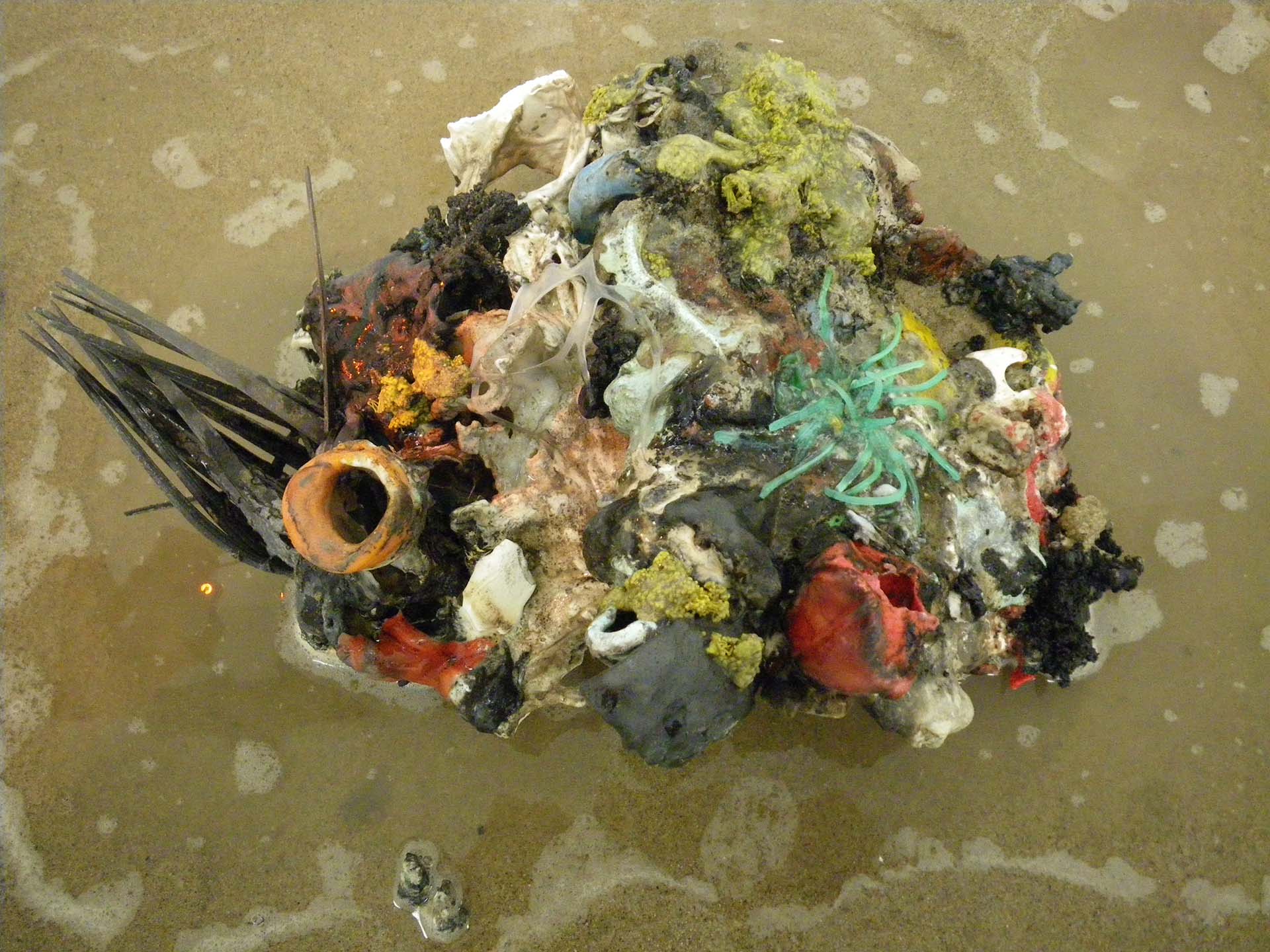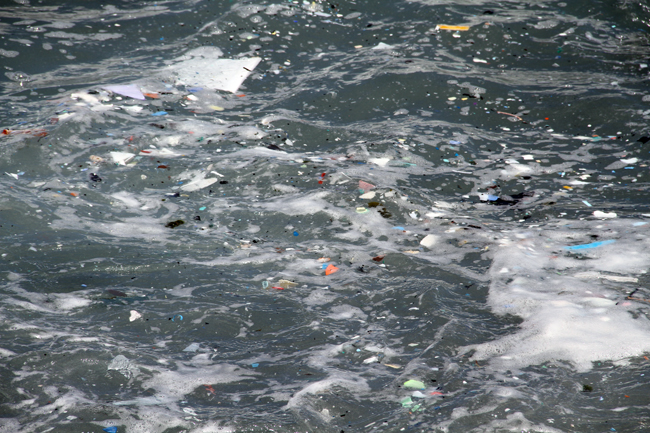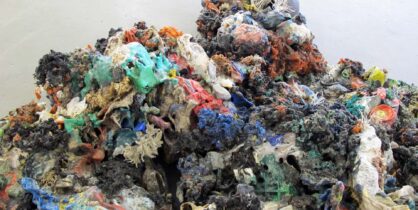The Plastic Reef Project, Part 1
Belgian sculptor, Maarten Vanden Eynde, talks to Revolve Magazine about the development of his Plastic Reef Project, the Foundation Enough Room for Space, and his experience in Georgia.
What’s the origin of the Plastic Reef Project ?
In March 2008, I found out that there was a “floating landfill”, about the size of the United States, made up of plastic particles, swirling in the Pacific Ocean about 1,000 miles west of California and 1,000 miles north of the Hawaiian Islands. Almost nobody knew about it at that time so I wanted to raise awareness about this incredible phenomenon and find out what could be done with this new ‘raw’ material.
In January 2009, I visited Charles Moore, marine researcher at the Algalita Marina Research Foundation in Long Beach, who discovered the Plastic Garbage Patch in 1997. He gave me a first sample of plastic debris from the North Pacific Gyre which I melted into a small plastic coral reef, the size of a football. The trash became beautiful again and seemed to solve two problems at the same time: the plastic in the ocean and the disappearing coral reefs around the world.

I decided to make the Plastic Reef as big as possible and went to the Hawaiian Islands which are located in the center of the North Pacific Gyre and are getting an incredible amount of plastic flotsam on their beaches. For one day, I joined the volunteer group B.E.A.C.H. that is collecting, categorizing and counting every piece of plastic they find. They shipped five boxes after my departure which made the reef grow to about 1 m2.
In February 2010, I joined the Pangaea Explorations on their boat Sea Dragon, which is doing research on plastic pollution worldwide. We crossed the Atlantic Ocean to gather as much plastic as possible and melt it into the growing Plastic Reef. In total, I fished out almost 400 kilos, making the Plastic Reef, after three weeks of melting, about 2 x 3 m2. In the end, I want to have samples of all the five existing gyres and by 2012 I want the reef to grow to a monumental sculpture of 5 x 10 m2.
How long will the Plastic Reef Project continue?
The physical work should be finished by the end of 2012, closing a 5 year working and research period. I want to launch a publication about the project as well which will be distributed worldwide and will somehow continue the dialogue about the problem of plastic.
What’s your ultimate goal with this project?
The main goal is to raise awareness about the issue of plastic pollution. In parallel to the physical work, I also participate in workshops and think tanks to imagine possible solutions for this incredible issue. With my work I won’t solve the problem directly, but it might stimulate people with the necessary skills to do it and hopefully help people to deal with plastic in a more conscientious way. Plastic is part and parcel of our throw away consumer culture, but although it is being discarded so quickly, it is one of the slowest degrading materials. Plastic debris will be the longest lasting remnant of human civilization.
What are some of your earlier influences?
I’m interested in many things: I’m a typical homo polymaticus – a multi-human. I like archaeology, geology, ethnography, anthropology, cosmology, philosophy… I can be fascinated about a complex society of ants, while simultaneously wanting to know as much as possible about the hunt for dark matter or the so called ‘god’ particle in the universe. Things coming from the ‘natural’ world have an influence on my work as an artist as much as the work of other artists.
What are some of your other ongoing projects?
I’m involved with the Foundation Enough Room for Space (www.enoughroomforspace.org) that I started with Marjolijn Dijkman in 2005. The organization is open for other participants and functions as a platform for various projects that are organized and coordinated by different people. ERforS stimulates the creation of physical, virtual and mental space for cultural initiatives by initiating and coordinating events and residence/research projects worldwide. ERforS stands for openness, diversity and experiment. It wants to get and give an image, as diverse as possible, of the earth and its inhabitants. With art as a stimulator, communicator and initiator, ERforS wants to expose different processes of being part of this world and how we deal with our environment.

Working together with different institutions, establishments and initiatives, a rich breeding ground is created for the constantly changing group of participants. The group includes visual artists, writers, film-makers, scientists and designers. Depending on the geographical and institutional location, the project is then elaborated with the length, amount of participants, ways of documenting and presenting a concept or starting point to provide a final outcome. Every possible way of collaborating or working together is being utilized and used for the development and creation of committed art. Cross-cultural experiences are one of the reasons for Enough Room for Space. It is only by looking at the other that one finds himself.
Tell us about your experience in Georgia.
I was first in Georgia in 2006 within the framework of an exchange project by Enough Room for Space and Expodium in collaboration with GeoAIR. After the Rose Revolution in 2003, the new Georgian president Mikheil Saakashvili called back his fellow country-men, who had fled Georgia in the past decades, to come and help rebuild the once prosperous country into a modern western democracy. We decided to respond to this call as well and see how a new democracy was being introduced or rather implanted and what the side-effects would be from such an enormous political and sociological shift. Eight artists living in the Netherlands went to Tbilisi and a few months later eight Georgian artists went to the Netherlands for a similar research period. A documentary was made of both periods and a presentation took place of newly developed works.
Five years later, we went back and the shock was enormous. The plans to revive or regenerate the country were there already five years ago, but we only saw the result when we came back. Tbilisi and several other cities are pimped beyond recognition. They all start to look like any other European restored capital. Many of the typical ancient old buildings are rebuilt in a fake old style and fancy coffee shops have replaced the street vendors, helped by an incredibly large police force in brand new cars and offices. Free artistic activity is almost non-existent. Some make crap paintings for the tourist market, some become hobby artists next to their regular jobs at a bank or bar, and the most interesting and ambitious artists moved out of the country. I can’t blame them. The capitalist carpet which is being rolled over Georgia is horribly suffocating.
Do you believe globalization has been positive?
I don’t think it is just positive or negative. It is always both, because it depends who is benefiting from it. Some animals thrive in newly conquered areas at the expense of others, usually indigenous species. Humans are no exception from this phenomenon; one man’s meat is another man’s poison.
On a personal level, I love to travel to other places in the world and I love to be able to eat a fresh kiwi from New Zealand any time a year coming from my local supermarket, but what is the price we have to pay for these luxuries? And I’m not talking about money… I would describe globalization more as unavoidable and possibly even natural, but never just positive.
Plastic
The word “plastic” comes from the Greek “plastikos” meaning “to form”. Plastic can be heated and molded into forms, such as the Plastic Reef sculpture.
Plastic is most used material in the world – also the longest to disintegrate.
Plastic is insoluble in water and most degrade very slowly. Some companies are exploring how to make more biodegradable plastics for packing.
Plastic waste has been accumulating over the years and has been coalescing with the rotating movement of the ocean currents (gyres) into Great Garbage Patches of debris the size of the United States. The Plastic Reef Project includes plastic samples from all 5 ocean gyres.
Petroleum and natural gas are needed to make most plastics, which means that with depleting oil reserves, companies are looking into shale gas and tar sands to extract petroleum to make plastics. But such extraction processes are expensive and likely to push the price of plastic into exorbitant, which hopefully will stimulate companies to find less polluting alternatives to synthetic plastic.
